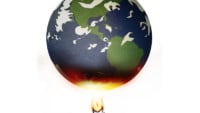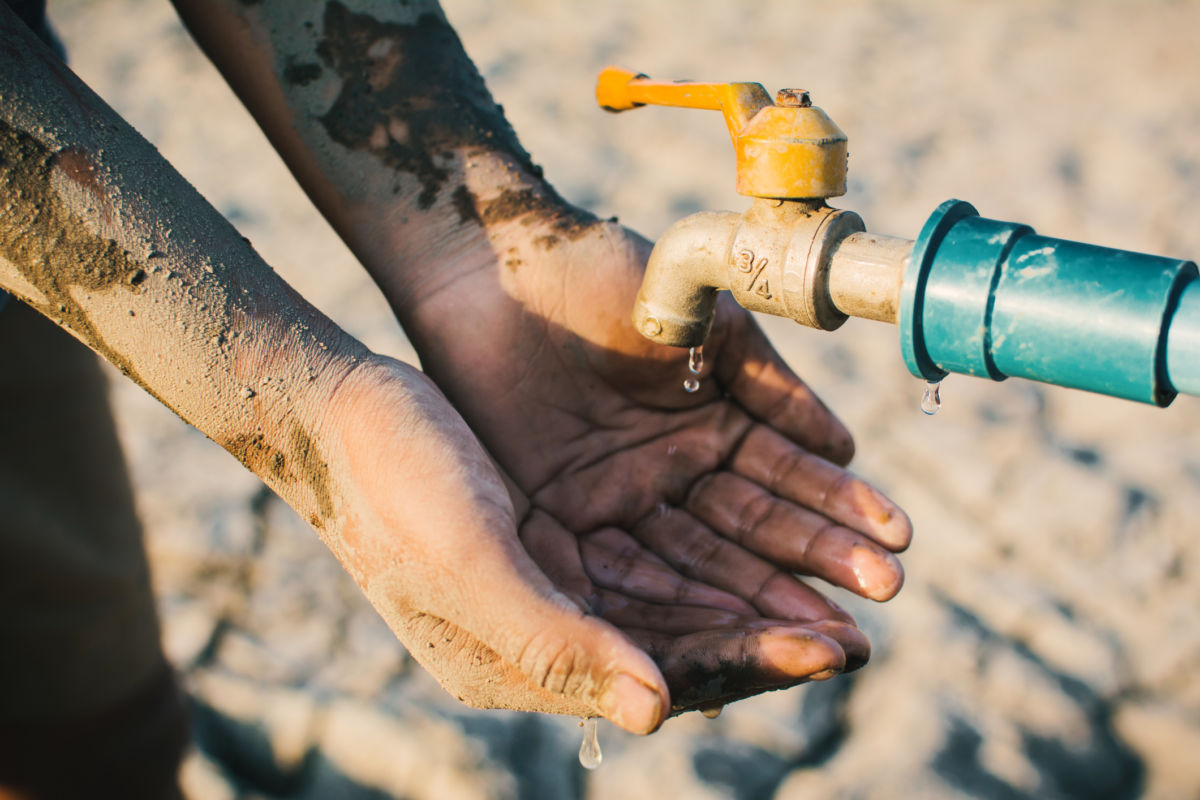
MENU
NEWS
ENVIRONMENT & HEALTH
Over One-Tenth of Global Population Could Lack Drinking Water by 2030
As civilization faces existential threats, Trump is trying to end long-term climate studies. Meanwhile, the global water crisis spurred by climate disruption continues to unfold dramatically.
SAWITREE PAMEE / EYEEM
BY
Dahr Jamail,
Truthout
PUBLISHED
July 1, 2019

PART OF THE TRUTHOUT SERIES
Climate Disruption Dispatches
Outside on my front porch, alder chip smoke billows out of my small smoker. The racks inside the tin smoker are filled with wild-caught Alaskan Coho salmon, provided to me by my friend Jonathan. He and his wife take their three daughters in their fishing boat and head north from our town on the north coast of Washington State’s Olympic Peninsula for the late summer salmon runs in Southeastern Alaska. They return with a hull full of frozen fish, for those of us here lucky enough to have placed our orders for it.
Several friends here attached to the land where I live are also outside, busy doing their own things: one is preparing his sailboat to launch in a week, another is working in the garden, two others are pitching a tent, another is out working his summer job with the Washington Conservation Association, and still another is reading and contemplating what she might write in the next column we co-author for
Truthout.
It is truly idyllic. A dream I’ve had for decades is finally coming true: I’m living in a way that is close to the Earth, which enables me to minimize my carbon footprint. I’m growing much of my own food and living in community with like-minded people.
recent study published in the Proceedings of the National Academy of Sciences showed that sea-level rise could be twice as bad as previously expected, due to accelerated melting in the Antarctic and Greenland. Instead of the previous worst-case scenario of 1 meter by 2100, the study has doubled that figure. Several scientists this writer has interviewed believe the realistic figure of sea level rise by 2100 will be even higher than this recent study’s prediction.
Another report showed how the state of Florida could be facing a $76 billion bill to mitigate and adapt to climate crisis impacts by just 2040, mostly from rising sea levels.
To give you an idea of how far along we already are in this crisis, in some areas of China, fruit trees have to be
pollinated by hand due to lack of pollinators. Climate disruption is a major contributing factor toward the loss of insects around the planet.
The Arctic, our proverbial canary in the climate coalmine, just saw its
hottest May ever recorded. Coastal erosion of permafrost is happening at a rate of up to one meter every day, and the current rate of coastal erosion is already six times higher than the historical rate.
In Siberia, carbon-laden permafrost has
warmed by 1.6 degrees Fahrenheit (1.6°F) in just the last 10 years alone. This is an ominous sign, for as the permafrost thaws it releases carbon and methane, making this one of the most dangerous feedback loops in the climate crisis, given that permafrost around the globe contains twice the amount of carbon that is already in the atmosphere. In fact, it has now been shown that the permafrost is
thawing 70 years sooner than previously predicted.
According to a
2017 study, tundra in Alaska is already warming up so quickly that it has become a net emitter of CO2 ahead of schedule — rather than sequestering carbon, as it has historically done. Thawing is occurring so rapidly in the Arctic now,
sinkholes are becoming increasingly common across the region.
To make matters worse, Arctic sea-ice extent for early June was at
a record low, and the ice could be on track now for a record melt year at the current trajectory.
Underscoring the severity of the crisis, yet another
well-researched report has recently been released warning the end of human civilization could be on the horizon if we don’t change course. In the report, climate scientists predict 2050 as the year we face complete climate catastrophe.
The authors predict, “More than a billion people may need to be relocated, and in high-end scenarios, the scale of destruction is beyond our capacity to model, with a high likelihood of human civilisation coming to an end.”
They
found that by 2050, total ecological collapse could bring about huge social consequences like “increased religious fervor to outright chaos.” The report warns that catastrophic environmental disasters could result in widespread pandemics, forced migrations from places that no longer support humans, and the spread of war over diminished resources.
The
report describes one possible scenario, in which “planetary and human systems (reach) a ‘point of no return’ by mid-century in which the prospect of a largely uninhabitable Earth leads to the breakdown of nations and the international order.”
It would be an error to think there is that much time before this kind of breakdown. If you live on the delta in Bangladesh, or in Paradise, California, or on the coastline of northern or western Alaska, the crisis is already upon you.
Earth
Extreme weather events fueled by human-caused climate disruption are already severely affecting food production, causing food price shocks in the U.S. A
report focusing on the recent flooding in the Midwest illustrated how rain-sodden fields across the Corn Belt, along with massive numbers of drowned livestock, are contributing factors. This issue is only set to deepen.
Meanwhile, despite the fact that human-caused climate disruption is, in many ways, a geoengineering experiment gone badly, ongoing discussion within the scientific community of using geoengineering to completely solve it continues to escalate.
Despite the clear dangers of unforeseen consequences, generating conflict between nations, and the immorality inherent in the idea of attempting to control parts of the biosphere, some scientists are
proposing strategies like spraying aerosols of sulphate particles into the stratosphere and using tall ships to pump salt particles from the ocean into polar clouds to brighten them in order to attempt to refreeze warming parts of the polar regions.
Meanwhile, experts from 27 different national science academies released a
report showing how climate disruption is already negatively impacting people’s health via heatwaves and floods, but also indirectly by things like the spreading of mosquito-borne diseases and deleterious mental health impacts.
“There are impacts occurring now [and], over the coming century, climate change has to be ranked as one of the most serious threats to health,” Andrew Haines, a co-chair of the report for the European Academies’ Science Advisory Council
told The Guardian.
Water
The endangered North Atlantic Right Whale’s already scant population is declining, and this decline has been linked directly to oceanic warming, which is of course, being caused by climate disruption, according to a
recent report. Warming oceans have caused the whales’ food supply to shift locations, causing them to have to travel farther to find it, along with moving them into areas closer to shipping lanes which are dangerous for them.
Meanwhile, dozens of grey whales have been found dead and washing up onto beaches up and down the west coast, from California to well up into Canada, causing U.S. scientists to
launch an investigation into the unusually high mortality event. Scientists believe the number found dead is but a fraction of the actual number, since most of the dead whales will not wash ashore.
“Many of the whales have been skinny and malnourished, and that suggests they may not have gotten enough to eat during their last feeding season in the Arctic,” National Oceanic and Atmospheric Administration (NOAA) spokesman Michael Milstein
told reporters of the mortality event.
Also, hundreds of “severely emaciated” dead puffins have washed ashore at St. Paul Island in the Pribilofs of Alaska, believed to have starved to death from the warming waters they forage from having
less food available for them to eat. Estimates of the total number of dead puffins range from 3,000 to 9,000.
A stunning
study published in the Proceedings of the National Academy of Sciences showed that warming oceans will likely reduce the oceanic content of fish and other marine life by one-sixth by the end of this century. The study warned that for every 1 degree Celsius (1°C) warming of the world’s oceans, the total mass of sea animals is projected to drop by five percent.
Meanwhile, the global water crisis spurred by climate disruption continues to unfold dramatically. A recent
report warned that by 2030, half of the entire population of India (roughly 700 million people, or to put another way, one tenth of the entire population of the globe), may lack adequate drinking water. (This is, of course, in addition to all the other places in which drinking water supplies will be inadequate.) The same
report warned that the cities of Bangalore and New Delhi could run out of useable groundwater by as early as 2020.
Read the rest here
Over One-Tenth of Global Population Could Lack Drinking Water by 2030












